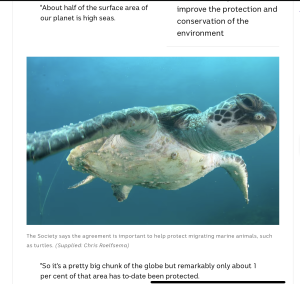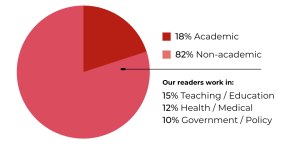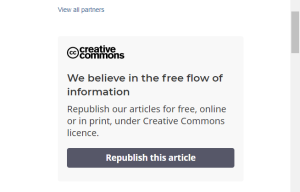Legacy news sites and digital-born news websites are two important publishers of online journalism, and their news content has similarities and differences. This article will select ABC News and The Conversation as traditional news websites and electronic news articles, respectively. Taking news stories that publish relevant High Seas Treaty as an example, compare the similarities and differences in news story production between the two.
ABC NEWS: abc.net.au/news/
Publishing contexts
ABC is one of the top legacy news and media publishers in Australia. Since its inception in 1932, the Australian Broadcasting Corporation has grown significantly. ABC News is the part of Australian Broadcasting Corporation to provides news and current affairs content that is highly trusted and offers a uniquely Australian perspective. which means the main target audience of ABC News is all Australians.
ABCs ’Annual Report (2021) records an average of 12.4 million users per week using ABC News’ online website and applications. The corporate tracking study selected a nationally representative sample of 18-75-year-olds interviewed and found that 77% of Australian adults trust the information provided by ABC. According to the Reuters Digital News Report (2022), the average weekly reach of ABC on third-party platforms is a year-on-year increase of 2.7%. While the number of people using social media as their primary source of news has all decreased, the age demographic difference remains significant, with more than half of 18-23-year-olds using social media as their primary source of news, compared to just 4% of those aged 75+. The target audience of ABC News cannot be defined in a specific range, it changes with ABC’s development plans. ABC Online News sites still target audiences who use media platforms to access news between 18-75 years old after the impact of the epidemic (ABC,2022).
ABC NEWS: International High Seas Treaty a ‘huge leap forward’ for marine conservation.
This news is about the important contribution of the International High Seas Treaty to Australia’s marine conservation, it was posted the ABC Wide Bay by Grace Whiteside, Wed 8 Mar 2023.
Content production
As the core of online journalism writing, ABC NEWS always keeps a good form of brevity (Bradshaw, 2018). This news did a great ‘chunking’ to express the meaning of each paragraph of the text more clearly. Heading and subheadings are clear and with the keyword of the content, and there are three “key points” obviously on the right side of the first paragraph of the text that gives more information and summaries of the news content. The ‘keywords’ and ‘key points’ make it possible to give readers effective content output and find news links in search engines more effectively and quickly.

However, there is a small lapse in the use of images combined with text, in this news, the image of turtles breaks up the text into two paragraphs which are talking about the same content of the area of the high seas, not the turtle. It may reduce the effectiveness of the brevity requires the story to try to keep one concept per paragraph and tends to confuse the reader. This image could be changed to the map of the high seas or the aerial view of the high seas and combine these two paragraphs.
In general, in terms of content and form, the complete tags, the use of white space, the relatively clear paragraph distribution, and the appropriate length of the article make it strongly readable.
Hypertextuality
The ABC does a bit hypertextual in this news. The text is hyperlinked to the background story news that “the international treaty was agreed on in New York on Saturday”, but there is only this one text hyperlink in the full text. The topic of this story revolves around the context of the International High Seas Treaty, so it should link the text of the Treaty to the sources of its content and allow the reader to better understand how its adoption has helped to protect Australia’s oceans. At the end of pages, ABC provides three related stories for readers to explore more information about marine protection.
Interactivity
Some dialogic and registrational interactivity is provided by ABC (Tapas, R.2006). There is a share button and a web link copy button in the top right corner of the news page and at the center and end of the text. However, there are only three other social platforms that can be linked to directly in the share function, otherwise, readers can only interact with other platforms by copying links. The sharing function could be improved by adding more options for direct links to other social media platforms such as Instagram.
At the end of the text, a hyperlink is provided to the ABC Wide Bay home page, users can interact on multiple platforms by opening new ABC branch pages and signing up to subscribe to their newsletter every week.
The Conversation: theconversation.com/au
Publishing contexts
The Conversation Australia and New Zealand is a digital-born publisher of research-based news and analysis, established in Melbourne in 2011. A not-for-profit company funded by university and research partners, several charities, and individual donors, The Conversation’s team is led by editor Misha Ketchell and chief executive Lisa Watts. The form of The Conversation is a combination of academic and journalistic content, providing important, high-quality explanatory news stories relevant to livelihoods(The Conversation, 2023).

Different from legacy news sites like ABC News, digital-born News sites focus on a more specific audience group. The Conversation targets users who want trusted information and new ideas, whether non-academic or academic. According to The Conversation’s user demography source by Google Analytics, the monthly audience of The Conversation Australia is 4.2 million unique users onsite, and 13.3 million through republication in January 2023. Based on the 2022 Stakeholder Report and Reader and Author Survey 2022 released by The Conversation, revealed that the audience did not differ significantly in gender, with 52% of males and 48% of females. Readers are younger, with 68% under 44 years old. 82% of the audience was non-academic, which means The Conversation tends to provide and share academic knowledge directly with the public(The Conversation, 2023).
The Conversation: We now have a treaty governing the high seas. Can it protect the Wild West of the oceans?
Content publication
The format of this story combines journalism and academics, and the brevity of journalistic writing is still followed in the writing. The use of a question by the author in the headings captures the reader’s attention. The subtitle is also a short question to separate each part of the content. As a news story containing academic analysis, it contains more text narrative and is longer generally than the ABC news story. Even though the story does insert some images for multimedia, the use of white space and “chunking” is much more constrained compared to the ABC news story.
Dr. Sarah Lothian the author of this story, is not a professional journalist, her writing style is more academic and critical, and this story provides more of a professional analysis from a marine conservation perspective while coverage of the high seas treaty is more professional in its output value.
Hypertextuality
The text is hyperlinked to all relevant sources of information, including numbers, reports, and other background-related news, and they are all paraphrased with keywords, and all links embedded are fully functional. In particular, the lack of the International High Seas Treaty content source link, mentioned above as appearing in ABC News, is addressed in this text. The first paragraph of the text contains the link to the agreement which was reached in New York on Saturday night, readers can directly access the UN website to read the official description of the agreement on the High Seas Treaty through this link.
Besides, there are two “read more” links placed in the middle and at the end of the text, providing readers with the option of reading more related stories to understand marine protection. The Conversation does a better link to the author, the profile and disclosure statement of the author are displayed on the right side of the page.
Interactivity
The Conversation provides various opportunities for users to interact with journalists, content, and each other (Bradshaw, 2018). Like ABC News, it provides registrational interactivity for users by signing up and subscriptions. In addition, Under the text, the subscriptions module introduces random news services in different research areas or The Conversation’s donation program, allowing users to subscribe not only to newsletters but also to donate to support The Conversation’s services.
The Conversation encourages users to engage in commentary and community interaction subject to community rules and provides more dialogic interactivities than ABC News’ share-only feature.

It is worth noting that The Conversation allows the user to republish their articles for free, online or in print, under Creative Commons license. This is an important feature of The Conversation to achieve a high level of interactivity. Tap into this function on the right side of the page to copy the HTML into users’ CMS to republish the articles on other platforms. User-generated content(UGC) is an important aspect of media interaction, and The Conversation gives users a very high level of trust and freedom to regenerate stories, which drives more user engagement than news sharing and greatly increases the spread of stories and the multiplatform multimedia nature of news stories.
Conclusion
ABC News seems to have an advantage in web writing and the brevity of format. Traditional news websites are more professional in news writing, and the use and combination of multimedia are also more scannable, in line with the web writing principles. However, The Conversation, as a digital-born news site, does a better job than ABC in terms of hypertextuality and interactivity. The Conversation’s news stories link to more sources of information, and its free republish feature provides users with more opportunities to participate in the news. The content and audience of the two publishers have similarities and differences, and the audience should choose the appropriate online news website for themselves.
References
- ABC Annual Report 2021-2022 (Rep.). (n.d.). Retrieved from https://about.abc.net.au/reports-publications/abc-annual-report-2021-2022/
- ABC Corporate Plan 2022-23 (Rep.). (n.d.). Retrieved March 20, 2023, from https://about.abc.net.au/wp-content/uploads/2022/08/ABC_CorporatePlan2022_23.pdf
- (2018). Writing for the web. In The Online Journalism Handbook (2nd ed., pp. 72–98). Routledge. https://doi.org/10.4324/9781315761428-4
- Tapas, R.(2006) Multimediality, Interactivity and Hypertextuality, in Online Journalism, New Delhi: Foundation Books
- Martin, F. (2019). Commendary cultures. Sharing News Online, 21-60. doi:10.1007/978-3-030-17906-9_2
- In-depth analysis, research, news and ideas from leading academics and researchers. Retrieved March 20, 2023, from https://theconversation.com/au
- ABC News (Australian Broadcasting Corporation). (n.d.). Retrieved March 20, 2023, from https://www.abc.net.au/news/
- Lothian, S. (2023, March 07). We now have a treaty governing the high seas. Can it protect the Wild West of the oceans? The Conversation. Retrieved from https://theconversation.com/we-now-have-a-treaty-governing-the-high-seas-can-it-protect-the-wild-west-of-the-oceans-201184
- Whiteside, G. (2023, March 08). International High Seas Treaty a ‘huge leap forward’ for marine conservation. ABC Wide Bay. Retrieved from https://www.abc.net.au/news/2023-03-08/high-seas-treaty-a-huge-leap-forward-for-marine-conservation/102067092
Word count:1654

Be the first to comment